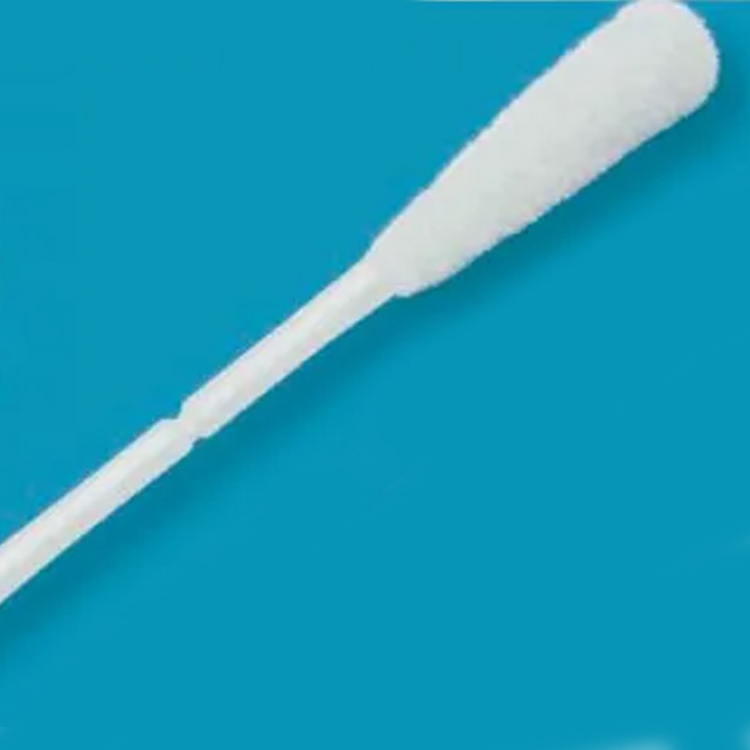There are two types of swabs for nucleic acid testing and antigen testing, namely nasal swabs and pharyngeal swabs. The pharyngeal swabs are usually 15 centimeters long, and the nasal swabs are 6 to 8 centimeters long. The “cotton swabs” you see for sampling are not the same as the skim cotton swabs we use every day. It is mainly composed of nylon short fiber pile head and medical grade ABS plastic rod.
Millions of nylon microfibers are vertically and uniformly attached to the handle by a spray and electrostatic flocking method. There is no absorption hole in the whole swab collection area, and DNA cells will not disperse in the retained fibers, which is conducive to faster and more efficient elution.
Flocking processing process will not produce toxic substances, flocking method makes nylon fiber bundles form capillary effect, is conducive to liquid samples like strong hydraulic absorption. Compared with traditional wound fiber swabs, flocking swabs can keep microbial samples on the surface of the fiber for rapid elution. 95% original sample, easily improved detection sensitivity.

As a rule, nasal swabs are not to be reused. If nasal swabs are reused, the consequences can be disastrous.
On the one hand, it increases the risk of viral infection. Earlier, a team in the UK found that two types of cells in the nose could be the primary source of infection in the Novel Coronavirus. In addition, clinical studies have found that nasal swabs carry significantly higher viral loads than throat swabs, and repeated use of nasal swabs is likely to cause cross-infection and spread the infection.
On the other hand, it may lead to inaccurate test results, presenting false positive or false negative. False positive results may cause psychological panic and unnecessary treatment; And false negative, it may make the test can not be detected in time has been infected, missed,The best time to treat, and cause even more infections.
Are nasal swabs as effective as throat swabs? What should I choose?
Currently, nucleic acid tests for COVID-19 are performed using throat swabs as well as nasal swabs. It is important to note that the throat swab is not the same as the nasal swab. It is relatively simple. The subject only needs to open his mouth and ask the examiner to extend the throat swab to take a sample.
Overall, nasal swabs have an advantage over throat swabs. First of all, in the process of throat swab testing, subjects are prone to dry cough, vomiting and other uncomfortable symptoms, while nasal swab subjects have better tolerance, and basically do not have uncomfortable reactions.
Second, because nasal swabs rarely cause discomfort, they can remain in the pharynx for longer periods of time, helping to obtain sufficient samples and improve the accuracy of the test. Improper swab collection can result in a “false negative” result.
In addition, for the inspector, the patient only needs to expose the nostril because the sampler can stand on the patient’s side and back during sampling.
So the risk of exposure is relatively low and the risk of infection is lower.
But while a nasal swab is superior to a throat swab, these six groups are not good candidates for a nasal swab.
- Hypertensive patients
- Severe allergic rhinitis
- Abnormalities in nasal cavity
- Patients with recent nasal bleeding symptoms
- Within 3 months after nasal surgery
- Long-term use of anticoagulant or antiplatelet drugs
What should we pay attention to for nucleic acid testing?
Today, the prevention and control of the epidemic cannot be relaxed, and many people from high-risk areas have requested nucleic acid tests. So, when doing nucleic acid testing, what should we pay attention to?
Before nucleic acid test: do not eat or drink within 2 hours, do not smoke or drink within 30 minutes, carry valid IDENTIFICATION, wear masks correctly, and inform test personnel of past medical history or related matters.
When taking nucleic acid test: keep a distance of more than 1 meter when queuing, tilt your head back slightly, relax, take a deep breath, and cover up dry cough or sneezing with tissue or arm.
After nucleic acid test: immediately leave the collection site and wipe hands with disinfectant or alcohol
The difference is that in order to collect pharyngeal specimens, one method is to collect oropharyngeal specimens by entering the oral cavity with sampling tools; One is to pass a sampling tool through the nasal cavity and collect nasopharyngeal specimens. They are therefore called oropharyngeal swabs and nasopharyngeal swabs respectively.
When an oropharyngeal swab sample is taken, the sampleer can see where the pharynx is being sampled. Irritation of the oropharyngeal mucosa may cause coughing, nausea, and even vomiting.
When taking nasopharyngeal swab samples, there is relatively little irritation to the nasopharyngeal mucosa if it is done properly. However, the sampler cannot see the position of the pharynx to be sampled and mainly relies on the perceived resistance of the hand to complete the sampling. Therefore, the technical requirements are higher and the tools used are more complex. At the same time, public acceptance of nasopharyngeal swabs was slightly lower.
Compared with nasopharyngeal swabs, oropharyngeal swab sampling is sometimes more difficult to meet normative sampling requirements due to irritant reactions. Combined with dietary, drinking and swallowing actions, oropharyngeal virus enrichment can be reduced to a certain extent, which may affect the positive test rate of oropharyngeal swabs.
RJC was established in 2002 and engaged in engineering service and technical manufacturing, such as rapid prototyping, mold manufacturing, injection molding, and CNC machining.CNC machining.RJC would be a good vendor choice.
click :https://rjcmold.com/contact-us/
Send inqury.

